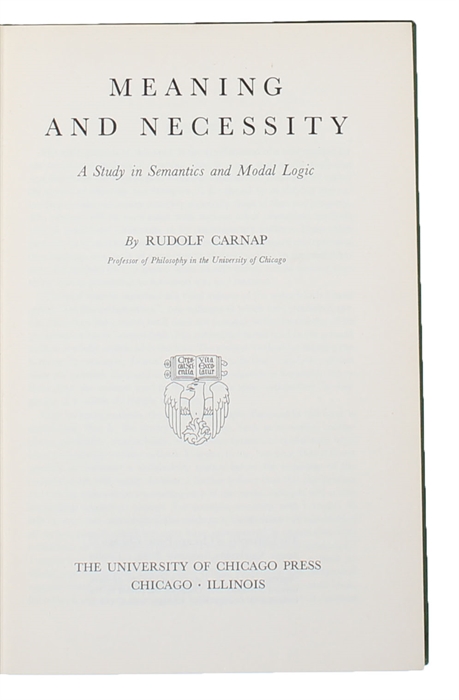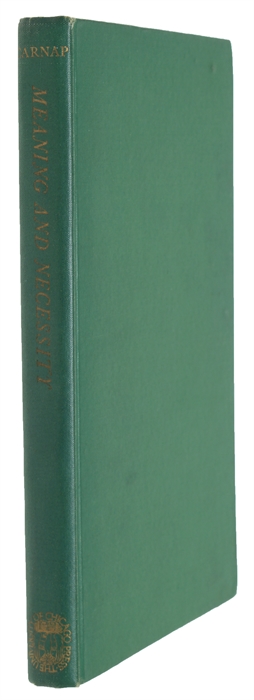QUINE'S COPY
CARNAP, RUDOLF.
Meaning and Necessity. A Study in Semantics and Modal Logic.
Chicago, (1947). 8vo. Orig. green full cloth w. gilt lettering to spine, minor bumping to extremities. With the ownership-signature of "W.V. Quine" to front free end-paper. A near mint copy. VIII, 210 pp.
The not common first edition, of Carnap's important main work on semantics, in which he, as the first logician ever, uses semantics to explain modalities. This led to an interest in the structure of scientific theories, and his main concerns here were to describe the distinction between analytic and synthetic statements and to suitably formulate the verifiability principle; -he thus wishes to find a criterion of significance that can be applied to scientific language. THE COPY HAS BELONGED TO THE GREAT LOGICIAN WILLARD ORMAN VAN QUINE and bears his signature to front free end-paper.
Rudolf Carnap and W.O. Van Quine are to of the greatest logicians of the 20th century and a copy like the present must me considered of the greatest interest. In the early 30'ies Quine met Carnap, under whom he studies in Prague, and according to Quine himself, Carnap's work was a great source of inspiration to him.
It is in his "Meaning and Necessity" that Carnap first defines the notions of L-true and L-false (Chapter II). A statement is said to be L-true if its truth depends on semantic rules, and L-false if its negation is L-true. Any statement that is either L-true or L-false is L-determined; analytic statements are L-determined, while synthetic statements are not L-determined. As opposed to the definitions he gives in his "The Logical Syntax of Language", these definitions now apply to semantic instead of syntactic concepts. It is also in this work that he gives his interesting explanation of his "belief-sentences"
Rudolf Carnap (born 1891 in Ronsdorf, Germany, died 1970 in Santa Monica, California) was an immensely influential analytic philosopher, who has contributed decisively to the fields of logic, epistemology, semantics, philosophy of science, and philosophy of language. He was one of the leading figures of the Vienna Circle, and a prominent logical positivist. He studied philosophy, physics and mathematics at the universities of Berlin and Freiburg, and worked at the universities of Jena, Vienna and Prague until 1935, when he, due to the war, emigrated to the U.S., where he became an American citizen in 1941. In America he became professor of the University of Chicago.
In Jena he was appointed Professor of Mathematics, though his main interest at that time was in physics. By 1913 he planned to write his dissertation on thermionic emission, but this was interrupted by World War I, where he served at the front until 1917. Afterwards he studied the theory of relativity under Einstein in Berlin, and he developed the theory for a new dissertation, namely on an axiomatic system for the physical theory of space and time. He thus ended up writing the important dissertation under the direction of Bouch on the theory of space (Raum) from a philosophical point of view.
After the publication of his first work, Carnap's involvement with the Vienna Circle began to develop. He met Reichenbach in 1923 and was introduced to Moritz Schlick in Vienna, where he then moved to become assistant professor at the university. He soon became one of the leading members of the Vienna Circle, and in 1929 he, Neurath, and Hahn wrote the manifest of the Circle.
According to Hintikka, Carnap came extremely close to possible-worlds semantics in his "Meaning and Necessity", but did not succeed, because he was not able to go beyond classical model theory (see "Carnap's heritage in logical semantics" in "Rudolf Carnap, Logical Empiricist").
Order-nr.: 42311


